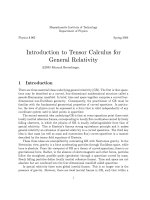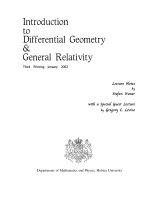Introduction to Special Relativity
Bạn đang xem bản rút gọn của tài liệu. Xem và tải ngay bản đầy đủ của tài liệu tại đây (656.33 KB, 2 trang )
Introduction to Special Relativity
Introduction to Special
Relativity
Bởi:
OpenStaxCollege
Special relativity explains why traveling to other star systems, such as these in the Orion Nebula,
is unreasonable using our current level of technology. (credit: s58y, Flickr)
Have you ever looked up at the night sky and dreamed of traveling to other planets in
faraway star systems? Would there be other life forms? What would other worlds look
like? You might imagine that such an amazing trip would be possible if we could just
travel fast enough, but you will read in this chapter why this is not true. In 1905 Albert
Einstein developed the theory of special relativity. This theory explains the limit on an
object’s speed and describes the consequences.
Relativity. The word relativity might conjure an image of Einstein, but the idea did not
begin with him. People have been exploring relativity for many centuries. Relativity
1/2
Introduction to Special Relativity
is the study of how different observers measure the same event. Galileo and Newton
developed the first correct version of classical relativity. Einstein developed the modern
theory of relativity. Modern relativity is divided into two parts. Special relativity deals
with observers who are moving at constant velocity. General relativity deals with
observers who are undergoing acceleration. Einstein is famous because his theories
of relativity made revolutionary predictions. Most importantly, his theories have been
verified to great precision in a vast range of experiments, altering forever our concept of
space and time.
Many people think that Albert Einstein (1879–1955) was the greatest physicist of the 20th
century. Not only did he develop modern relativity, thus revolutionizing our concept of the
universe, he also made fundamental contributions to the foundations of quantum mechanics.
(credit: The Library of Congress)
It is important to note that although classical mechanic, in general, and classical
relativity, in particular, are limited, they are extremely good approximations for large,
slow-moving objects. Otherwise, we could not use classical physics to launch satellites
or build bridges. In the classical limit (objects larger than submicroscopic and moving
slower than about 1% of the speed of light), relativistic mechanics becomes the same
as classical mechanics. This fact will be noted at appropriate places throughout this
chapter.
2/2









